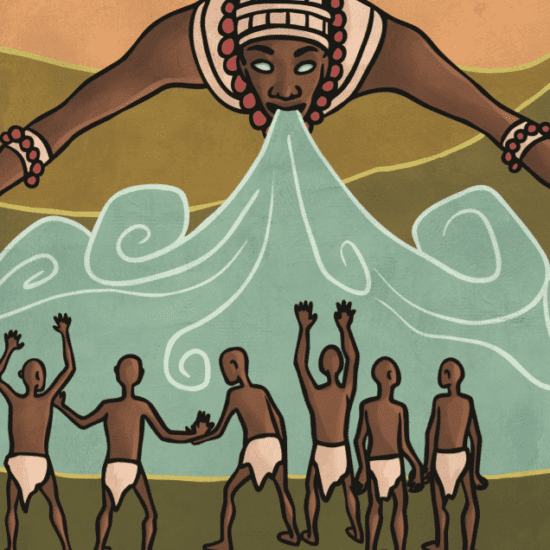The Ainu Creation Myth: Nature, Spirits, and Humanity’s Origins
Ainu mythology, rich with vivid imagery and profound symbolism, offers a unique perspective on the origins of the world and humanity. The Ainu people, an indigenous group primarily residing in Hokkaido, Japan, and parts of the Russian Far East, have a rich oral tradition that encompasses various myths, legends, and folktales. Among these, the creation myth stands out as a fascinating narrative that reflects the Ainu’s deep connection to nature, spirituality, and the cosmos.
The Beginning of Creation
According to Ainu mythology, the universe was once in a state of darkness, without land, sky, or any living beings. In this primordial void, there existed a powerful deity named Kamuy. Kamuy is often described as a creator god, embodying the essence of life and the spirit of the universe. In this time of nothingness, Kamuy decided to bring forth creation.
Kamuy took a handful of soil and mixed it with water from the sea, forming the first land. This new earth emerged from the depths of the cosmic waters, becoming the foundation of the world. As the land solidified, Kamuy created the mountains, rivers, and forests, breathing life into the barren landscape. Each element of nature was imbued with a spirit, or kamuy, signifying the divine presence in all aspects of creation.
The Birth of the First Humans
Once the earth was shaped, Kamuy realized that the world needed inhabitants. Thus, he created the first humans. The myth narrates that Kamuy took a small piece of his own flesh and transformed it into the first Ainu man and woman. These primordial beings were named Kuwak (the man) and Tuyne (the woman), and they were gifted with the ability to communicate with the spirits of nature.
Kuwak and Tuyne lived harmoniously in their new environment, surrounded by the kamuy that inhabited the trees, animals, and rivers. They honored these spirits through rituals and offerings, establishing a relationship built on respect and gratitude. The Ainu people believe that their ancestors are directly descended from Kuwak and Tuyne, which signifies the importance of maintaining a connection with the natural world.
The Role of Kamuy in Ainu Mythology
In Ainu mythology, Kamuy plays a crucial role not only as a creator but also as a protector and guide for the Ainu people. The deities are believed to be present in every aspect of nature, from the smallest insect to the largest mountain. This belief fosters a deep sense of reverence for the environment, emphasizing the interconnectedness of all living beings.
The Ainu celebrate their relationship with Kamuy through various rituals, such as the Iyomante, a bear ceremony that honors the spirit of the bear. This practice highlights the belief that the spirits of animals are an integral part of Ainu spirituality. Through these ceremonies, the Ainu express their gratitude to Kamuy and the kamuy of the animals for providing sustenance and life.
The Conflict and Harmony Between Humans and Nature
As the Ainu people multiplied, they began to interact with their environment more extensively. The creation myth also addresses the balance between humans and nature, illustrating the consequences of disrespecting the kamuy. A common theme in Ainu stories is the importance of maintaining harmony with the natural world.
In one popular tale, humans’ greed leads to a depletion of resources, angering the spirits of the land. In retaliation, the kamuy withhold their blessings, resulting in famine and hardship. This myth serves as a cautionary tale, reminding the Ainu people of the necessity to live in harmony with nature and respect the spirits that inhabit their world.
Legacy of Ainu Creation Myths
Ainu mythology, particularly its creation myth, continues to influence the cultural identity of the Ainu people today. Despite the challenges faced by the Ainu community, including cultural assimilation and loss of traditional lands, these myths serve as a source of resilience and pride. They provide a framework for understanding the relationship between humans and nature, emphasizing the importance of stewardship and reverence for the environment.
Modern Ainu activists are increasingly drawing on these myths to promote environmental awareness and cultural preservation. By sharing their creation stories, they hope to educate others about the significance of respecting nature and the importance of maintaining cultural heritage.
Conclusion
The Ainu creation myth offers a profound insight into Ainu mythology, illustrating the deep connection between the Ainu people, their environment, and their spirituality. The narrative of Kamuy, the primordial darkness, and the birth of the first humans reflects a worldview that emphasizes harmony, respect, and gratitude toward nature. As the Ainu continue to navigate the complexities of modern life, their myths remain a vital part of their cultural identity, inspiring future generations to honor the spirits of the land and the legacy of their ancestors.
Through the lens of Ainu mythology, we are reminded of the universal themes of creation, coexistence, and the intricate relationship between humanity and the natural world—principles that are increasingly relevant in today’s rapidly changing environment. By understanding and embracing these ancient narratives, we can foster a greater appreciation for the diverse cultural expressions that enrich our global community.










